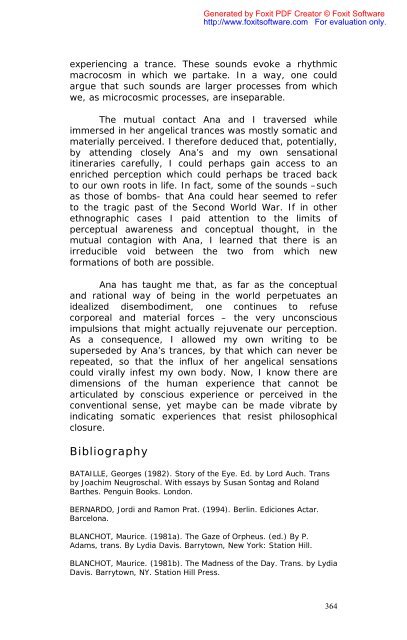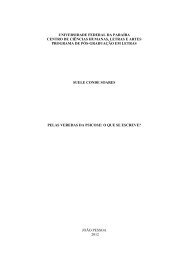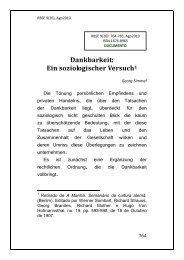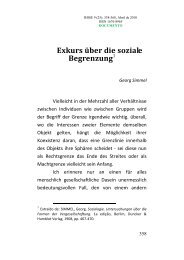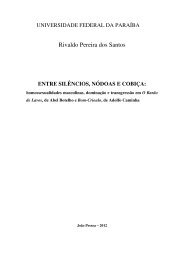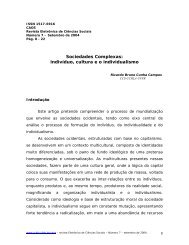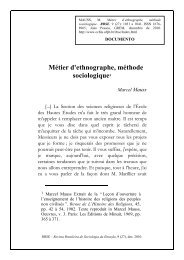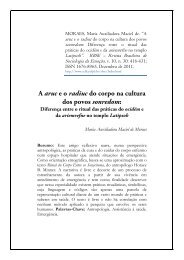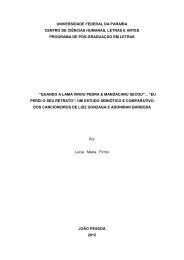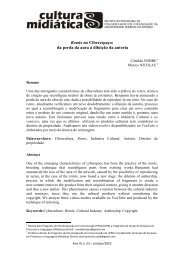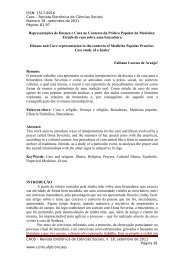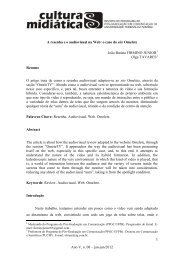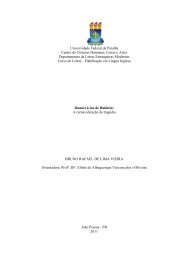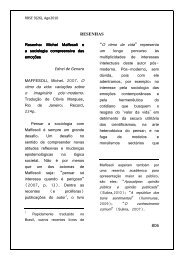Dádiva e Emoção - CCHLA - Universidade Federal da Paraíba
Dádiva e Emoção - CCHLA - Universidade Federal da Paraíba
Dádiva e Emoção - CCHLA - Universidade Federal da Paraíba
You also want an ePaper? Increase the reach of your titles
YUMPU automatically turns print PDFs into web optimized ePapers that Google loves.
experiencing a trance. These sounds evoke a rhythmic<br />
macrocosm in which we partake. In a way, one could<br />
argue that such sounds are larger processes from which<br />
we, as microcosmic processes, are inseparable.<br />
The mutual contact Ana and I traversed while<br />
immersed in her angelical trances was mostly somatic and<br />
materially perceived. I therefore deduced that, potentially,<br />
by attending closely Ana’s and my own sensational<br />
itineraries carefully, I could perhaps gain access to an<br />
enriched perception which could perhaps be traced back<br />
to our own roots in life. In fact, some of the sounds –such<br />
as those of bombs- that Ana could hear seemed to refer<br />
to the tragic past of the Second World War. If in other<br />
ethnographic cases I paid attention to the limits of<br />
perceptual awareness and conceptual thought, in the<br />
mutual contagion with Ana, I learned that there is an<br />
irreducible void between the two from which new<br />
formations of both are possible.<br />
Ana has taught me that, as far as the conceptual<br />
and rational way of being in the world perpetuates an<br />
idealized disembodiment, one continues to refuse<br />
corporeal and material forces – the very unconscious<br />
impulsions that might actually rejuvenate our perception.<br />
As a consequence, I allowed my own writing to be<br />
superseded by Ana’s trances, by that which can never be<br />
repeated, so that the influx of her angelical sensations<br />
could virally infest my own body. Now, I know there are<br />
dimensions of the human experience that cannot be<br />
articulated by conscious experience or perceived in the<br />
conventional sense, yet maybe can be made vibrate by<br />
indicating somatic experiences that resist philosophical<br />
closure.<br />
Bibliography<br />
Generated by Foxit PDF Creator © Foxit Software<br />
http://www.foxitsoftware.com For evaluation only.<br />
BATAILLE, Georges (1982). Story of the Eye. Ed. by Lord Auch. Trans<br />
by Joachim Neugroschal. With essays by Susan Sontag and Roland<br />
Barthes. Penguin Books. London.<br />
BERNARDO, Jordi and Ramon Prat. (1994). Berlin. Ediciones Actar.<br />
Barcelona.<br />
BLANCHOT, Maurice. (1981a). The Gaze of Orpheus. (ed.) By P.<br />
A<strong>da</strong>ms, trans. By Lydia Davis. Barrytown, New York: Station Hill.<br />
BLANCHOT, Maurice. (1981b). The Madness of the Day. Trans. by Lydia<br />
Davis. Barrytown, NY. Station Hill Press.<br />
364


